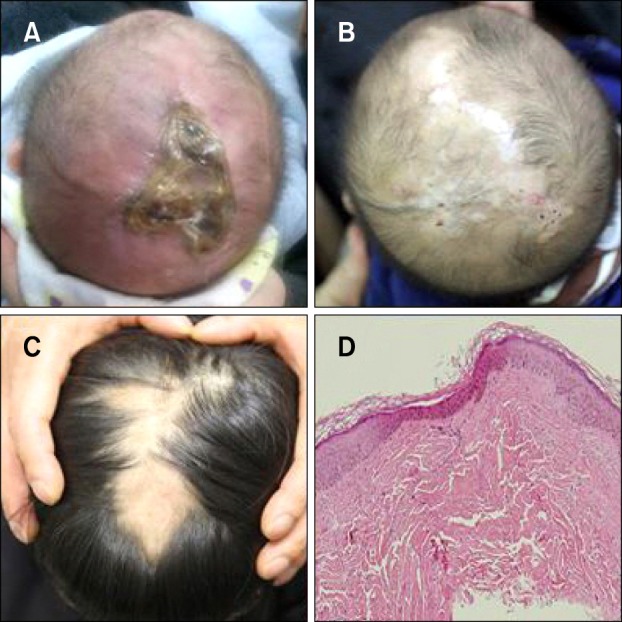Dear Editor:
Aplasia cutis congenita (ACC) is a rare congenital malformation, characterized by a localized defect of epidermis, dermis, and sometimes subcutaneous tissues123. Although it has been suggested that ACC results from disrupted development or degeneration of skin in utero, the pathogenesis remains unclear. There are five familial cases of ACC reported in Korea (Table 1)12345. Three cases were type VII ACC localized to legs123. The other cases were combined with syndromic conditions such as epidermolysis bullosa and Adams-Oliver syndrome45. Herein, we report 18-month-old male and his 8-year-old brother with ACC on their scalps, which represent type I ACC in siblings without associated congenital anomalies (Fig. 1A~C).
A 13-day-old infant was transferred to us for evaluation of a large ulcerated-crusted skin defect on the scalp, which was present since birth (Fig. 1A). The infant was born at term (38 weeks, birth weight 2,580 g) by caesarean section. The newborn was otherwise healthy with Apgar score 10 at birth. His parents were healthy without consanguinity, known medical problems, history of drug intake, infection or trauma during pregnancy.
He presented with a well-demarcated irregular ulcerated scalp defect covering an area 10×10 cm. Outside brain computed tomography and neurosonography showed no skull defects or abnormalities. There was no chromosomal abnormality such as trisomy 13 or 4p-syndrome. Clinical diagnosis was ACC, and he was treated conservatively by simple dressing with antibiotic ointment. After 18 months, he returned to discuss advanced treatment (Fig. 1B). We referred him to plastic surgeon for staged repair. A histological study confirmed the diagnosis of ACC, and there were no remnant viable hair follicles on the biopsy specimen (Fig. 1D).
ACC is a rare congenital disorder with an underlying mechanism that remains unclear. It is characterized by localized or widespread areas of affected skin most commonly on the scalp, and usually present at birth3. ACC may be associated with defects of the underlying skull, especially when the skin defect is larger than 10 cm2. Our patient had no underlying skull abnormalities, although he had a relatively large scalp lesion. According to Frieden's classification of ACC, type I (ACC of the scalp without multiple abnormalities) is most common with autosomal dominant or sporadic inheritance1. In our case, the parents had no evidence of ACC, indicating the inheritance pattern could be autosomal recessive or represent genetic mosaicism, both of which differ from the typical hereditary pattern of type I ACC.
In conclusion, we report a rare case of familial scalp ACC in Korea which follows atypical inheritance patterns. Our case could provide additional support for the diverse hereditary characteristics of type I ACC.
References
1. Jin SY, Kim DH, Lim WS, Choi YS, Lee AY, Lee SH. Aplasia cutis congenita in two siblings. Korean J Dermatol. 2012; 50:714–717.
2. Kim JY, Lee YK, Ko SY, Kim KA, Shin SM. Clinical course of aplasia cutis congenita. J Korean Soc Neonatol. 2011; 18:359–364.

3. Lim JH, Park H, Kim JW, Yu DS. A case of aplasia cutis congenita in two siblings. Korean J Dermatol. 2010; 48:517–520.
4. Kim YJ, Jee YH, Lee CH, Kim YC, Cinn YW, Kim EJ, et al. A case of Adams-Oliver syndrome which was observed in two brothers. J Korean Soc Neonatol. 2001; 8:171–174.
5. Kim HS, Hwang SJ, Kim CH, Kim DC, Park HR. Aplasia cutis congenita: a case report. J Korean Soc Plast Reconstr Surg. 1994; 21:365.
Fig. 1
(A) Clinical manifestation of irregular crusted skin defects at one month after birth. (B) Clinical features with non-hairy large shiny scar at 18 months after birth. (C) His 8-year-old brother also presented with scalp aplasia cutis congenita (ACC). (D) Histopathological findings revealed dermal fibrosis with absence of adnexal structure, consistent with ACC (H&E, ×200).

Table 1
Summary of reported cases of familial ACC in Korea

| Author | Sex | Location | Family relationship | Hereditary nature | Frieden's classification | Associated abnormalities |
|---|---|---|---|---|---|---|
| Kim et al.5 (1994) | M | Right leg | Mother (right leg) | AD or AR | Type VI | Epidermolysis bullosa |
| Kim et al.4 (2001) | M | Scalp | Brother (scalp) | AR or mosaicism | Type II | Adams-Oliver syndrome |
| Lim et al.3 (2010) | F | Left leg | Sister (both legs) | AR or mosaicism | Type VII | None |
| Kim et al.2 (2011) | F | Right foot | 2nd-degree relative (scalp) | AR or mosaicism | Type VII | None |
| Jin et al.1 (2012) | F | Right leg | Sister (left leg) | AR or mosaicism | Type VII | None |
| Present case | M | Scalp | Brother (scalp) | AR or mosaicism | Type I | None |




 PDF
PDF ePub
ePub Citation
Citation Print
Print


 XML Download
XML Download